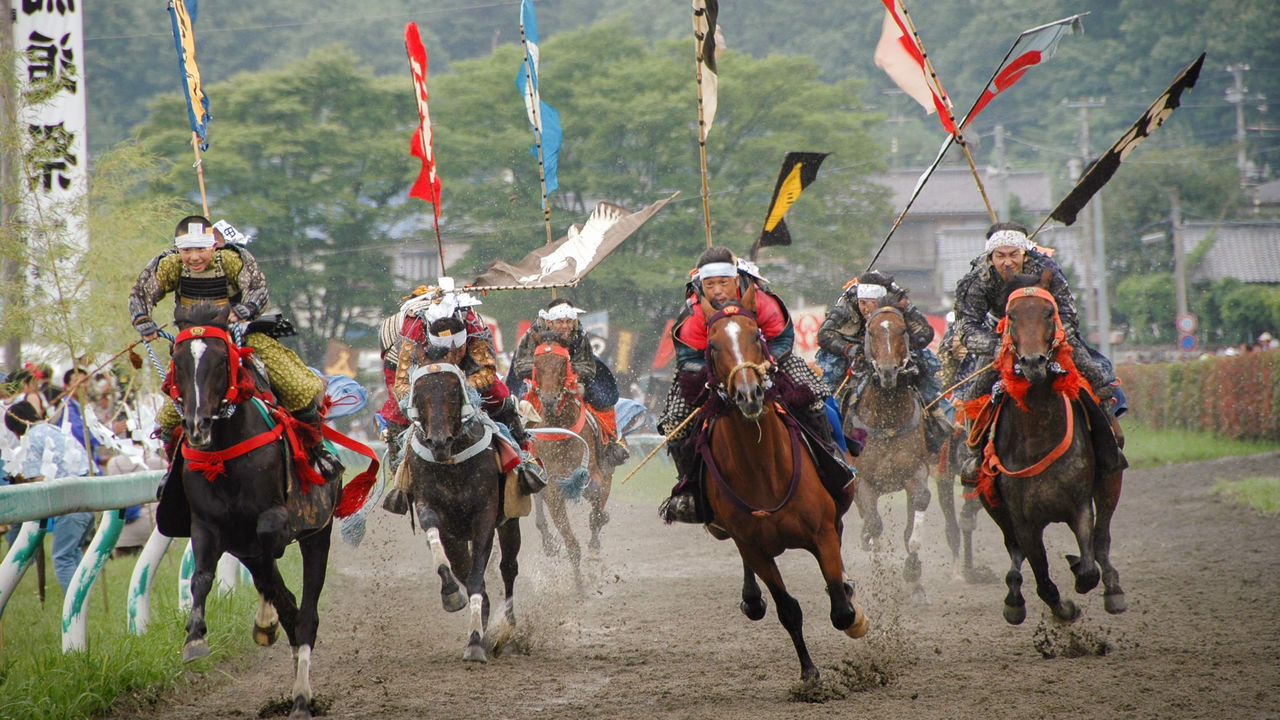
Fukushima’s Sōma Nomaoi: A Thrilling Festival of Mounted Samurai
Guideto Japan
Culture- English
- 日本語
- 简体字
- 繁體字
- Français
- Español
- العربية
- Русский
A 1,000-Year-Old Equestrian Celebration of Gallantry and Gravity
The Sōma Nomaoi, held in the city of Minamisōma, Fukushima Prefecture, is a captivating festival featuring around 500 men and women on horseback dressed as medieval warriors. Reputed to be the world’s greatest equestrian festival, the “Sōma Wild Horse Chase” has been designated as an Important Intangible Folk Cultural Property of Japan.
Over a millennium ago, Taira no Masakado—a rebellious warrior said to be the founder of the Sōma clan, which ruled the region—held a ritual that became the basis of the Sōma Nomaoi. After conducting military exercises in which wild horses were used as substitutes for enemy soldiers, Masakado would offer the captured horses to deities. The Sōma clan has kept this tradition alive in Minami Sōma since settling there in 1323. Even today, the role of the festival’s “commander-in-chief” is a filled by a descendant of the clan.
 The festival brings to life scenes from feudal Japan. (© Sōma Nomaoi Executive Committee)
The festival brings to life scenes from feudal Japan. (© Sōma Nomaoi Executive Committee)
The three-day festival held every year in late July is replete with highlights.
On the first day, participants in samurai attire ride out on horseback from three Shintō shrines to the accompaniment of trumpeting conch horns. The commander-in-chief is welcomed at the Kitagō headquarters with a solemn reception ritual called sōdaishō omukae, after which he and the other riders proceed to Hibarigahara Field, the main venue.
The shinki sōdatsusen (sacred flag competition), held on the second day, is the festival’s climax. In a spectacle reminiscent of the fierce battles of the Warring States period (1467–1568), as many as 500 warriors on horseback swarm together in an intense struggle to take possession of two sacred flags.
Armed Horse Race: Unity of Horse and Rider
 Riders in samurai armor urge their steeds through flying sand toward the goal. (© Sōma Nomaoi Executive Committee)
Riders in samurai armor urge their steeds through flying sand toward the goal. (© Sōma Nomaoi Executive Committee)
Another action-packed must-see is the kacchū keiba (armed horse race), which precedes the sacred flag competition. Riders clad in armor become one with their horses as they race around the track, colorful banners streaming from their backs. Rapturous cheers and thundering hooves add fuel to the excitement.
 Men dressed in white try to capture a horse in the nomakake ritual. (© Sōma Nomaoi Executive Committee)
Men dressed in white try to capture a horse in the nomakake ritual. (© Sōma Nomaoi Executive Committee)
The final day of the festival consists of a sacred ritual called nomakake (wild horse capture)—purportedly the only event in the festival that has not changed since ancient times. After mounted riders drive unsaddled horses into a fenced area, men in all-white outfits, including white hachimaki (headbands), chase and capture a horse of their choice, which they then present to the shrine deity.
An epic festival in which horses and riders guide spectators on a magical journey back through the centuries—that is the Sōma Nomaoi.
DATA
- Locations: Hibarigahara Field and other venues in Minamisōma, Fukushima Prefecture
- Access: 15 minutes by shuttle bus from Haranomachi station on the JR Jōban line
- Tel.: 0244-22-3064 (Sōma Nomaoi Executive Committee office)
- Dates: Last weekend of July
- Tickets: ¥1,000 same-day, ¥800 advance (open seating); tickets required only for the second day
- Multilingual information:
- Website available in English
- Pamphlets available in English, traditional Chinese, and Korean
Nearby Attraction
Minamisōma City Museum
 The museum is situated within the spacious Higashigaoka Park. (© Minamisōma City Museum)
The museum is situated within the spacious Higashigaoka Park. (© Minamisōma City Museum)
At the Minamisōma City Museum, visitors can view gripping videos and dioramas of the Sōma Nomaoi throughout the year. In addition to armors and ritual implements used in the festival, the museum exhibits the Sōma Nomaoi-zu Byōbu, a pair of folding screens depicting festival scenes that has been designated by Fukushima Prefecture as an important tangible folk cultural property. This is a great place to learn about the history and evolution of the 1,000-year-old celebrations. The museum also features materials about Minami Sōma from the Paleolithic period to the present day, offering an in-depth look into the lives of local people and the diversity of the region’s natural environment.
DATA
- Address: 194 Aza-deguchi, Gorai, Haramachi-ku, Minamisōma, Fukushima Prefecture
- Access: 10 minutes by taxi from Haranomachi station on the JR Jōban line
- Tel.: 0244-23-6421
- Hours: 9:00 am to 4:45 pm (final entry 4:00 pm)
- Closed Mondays (when Monday is a national holiday, closed the next day)
- Admission: ¥300 for adults; ¥200 for high school students; ¥100 for elementary and junior high school students
- Multilingual information: Pamphlets available in English
(Originally written in Japanese. Photographs, unless otherwise noted, and text by Shoepress. Banner photo: The kacchū keiba, in which armored riders gallop through the racecourse at breathtaking speed. © Sōma Nomaoi Executive Committee.)